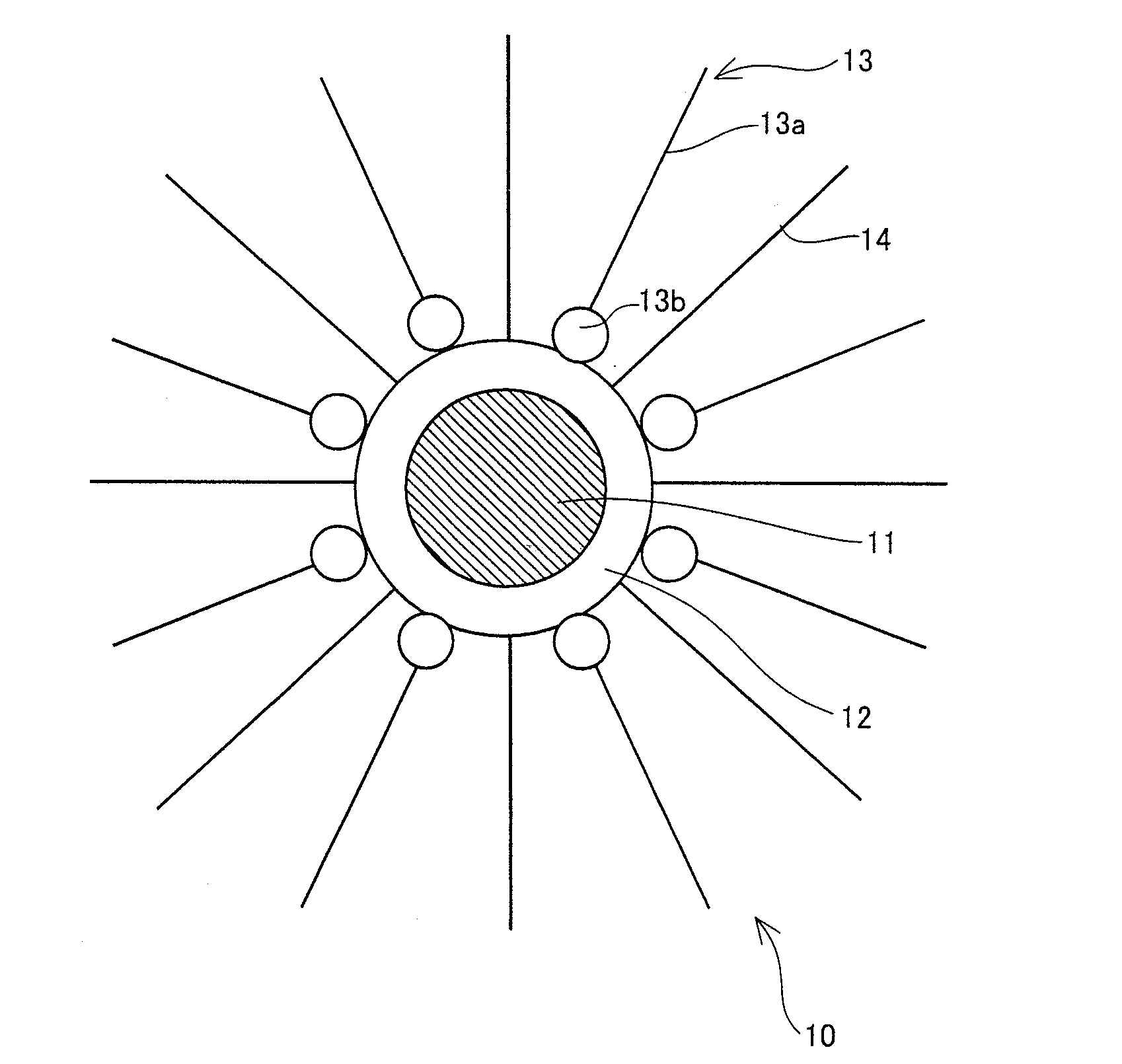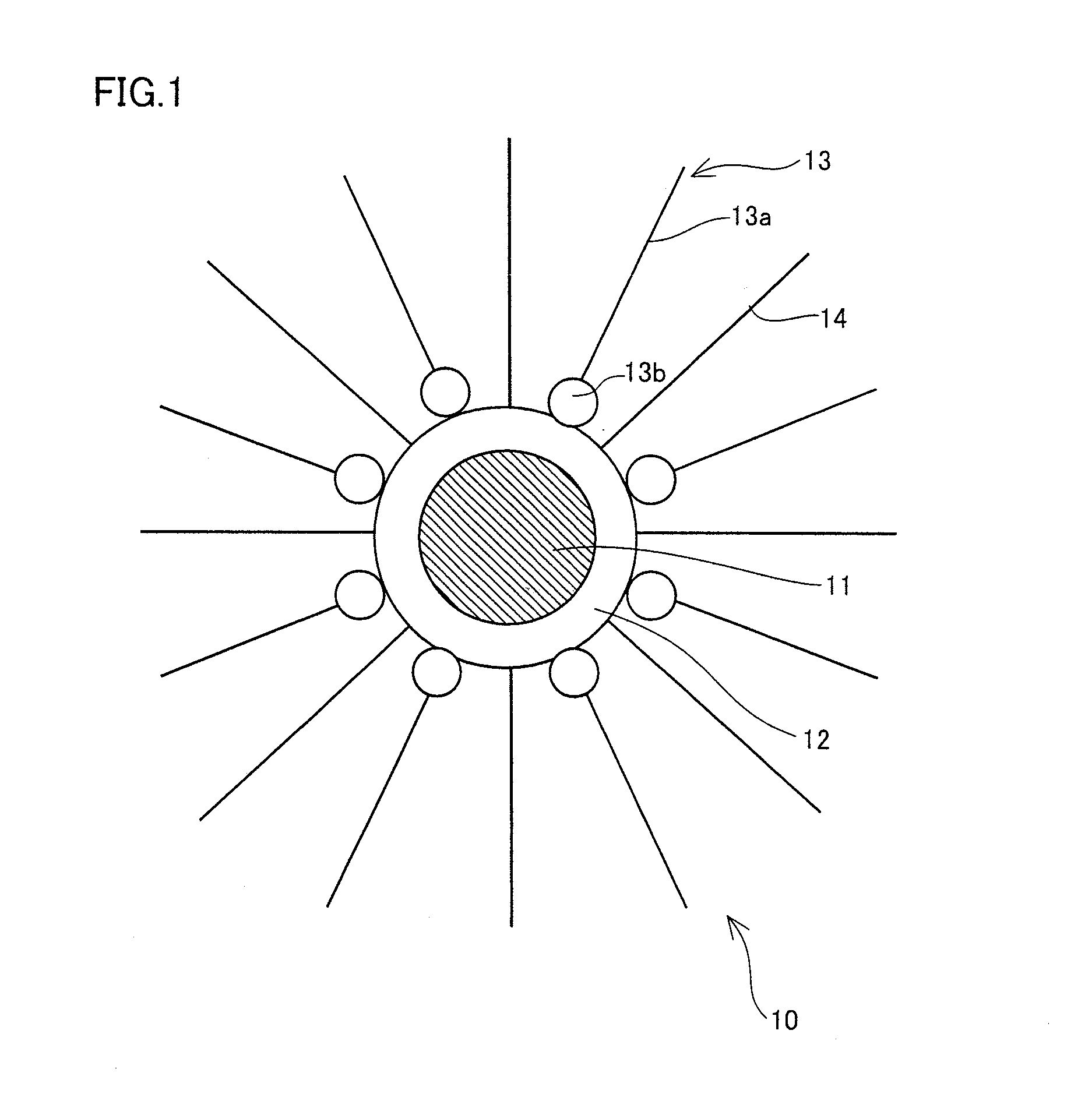Semiconductor nanoparticle production method, semiconductor nanoparticle, and phosphor using the same
a technology of semiconductor nanoparticles and phosphors, applied in the direction of luminescent compositions, crystal growth processes, polycrystalline materials, etc., can solve the problems of degrading the light emission efficiency of phosphor materials, and achieve high light emission efficiency, high heat emission intensity, and high light emission intensity
- Summary
- Abstract
- Description
- Claims
- Application Information
AI Technical Summary
Benefits of technology
Problems solved by technology
Method used
Image
Examples
example 1
[0061]By reaction of 0.5 mmol of gallium iodide and 1.5 mmol of dodecanoic acid under heating at 120° C. in 20 ml of 1-octadecene solution, 0.5 mmol of gallium dodecanoate solution was obtained (fatty acid salt synthesis step [1]).
[0062]Then, by adding 0.5 mmol of hexadecanethiol (HDT) to the gallium dodecanoate solution set forth above, and reaction of 0.5 mmol of indium iodide and 10 mmol of sodium amide under heating, a particle having the composition of “InN (nanoparticle core) / gallium dodecanoate (modification group 13 element-containing fatty acid salt), HDT (modification organic compound)” was produced (core formation step [2]).
[0063]By adding 0.5 mmol of gallium dodecanoate and 10 mmol of sodium amide obtained in a manner similar to that of the fatty acid salt synthesis step [1] set forth above to the aforementioned nanoparticle core solution for reaction under heating, there was produced a semiconductor nanoparticle of a core-shell structure having the composition of “InN (...
example 2
[0069]By a reaction of 0.5 mmol of indium iodide and 1.5 mmol of dodecanoic acid under heating at 120° C. in 20 ml of 1-octadecene solution, 0.5 mmol of indium dodecanoate solution was obtained (fatty acid salt synthesis step [1]).
[0070]Then, by adding 0.5 mmol of dodecanethiol (DDT) to the indium dodecanoate solution set forth above, and a reaction of 0.5 mmol indium iodide and 10 mmol of sodium amide under heating, a particle having the composition of “InN (nanoparticle core) / indium dodecanoate (modification group 13 element-containing fatty acid salt), DDT (modification organic compound)” was produced (core formation step [2]).
[0071]By adding 0.5 mmol of gallium dodecanoate and 10 mmol of sodium amide obtained in a manner similar to that of the fatty acid salt synthesis step [1] set forth above to the aforementioned nanoparticle core solution for reaction under heating, there was produced a semiconductor nanoparticle of a core-shell structure having the composition of “InN (nanop...
example 3
[0076]By a reaction of 0.5 mmol of gallium iodide and 1.5 mmol of dodecanoic acid under heating at 120° C. in 20 ml of 1-octadecene solution, 0.5 mmol of gallium octadecanoate solution was obtained (fatty acid salt synthesis step [1]).
[0077]Then, by adding 0.5 mmol of HDT to the gallium octadecanoate solution set forth above, and a reaction of 0.5 mmol indium iodide and 10 mmol of sodium amide under heating, a particle having the composition of “InN (nanoparticle core) / gallium octadecanoate (modification group 13 element-containing fatty acid salt), HDT (modification organic compound)” was produced (core formation step [2]).
[0078]By adding 0.5 mmol of gallium dodecanoate and 10 mmol of sodium amide obtained in a manner similar to that of the fatty acid salt synthesis step [1] set forth above to the aforementioned nanoparticle core solution for reaction under heating, there was produced a semiconductor nanoparticle of a core-shell structure having the composition of “InN (nanoparticl...
PUM
| Property | Measurement | Unit |
|---|---|---|
| mole ratio | aaaaa | aaaaa |
| temperature | aaaaa | aaaaa |
| temperature | aaaaa | aaaaa |
Abstract
Description
Claims
Application Information
 Login to View More
Login to View More - R&D
- Intellectual Property
- Life Sciences
- Materials
- Tech Scout
- Unparalleled Data Quality
- Higher Quality Content
- 60% Fewer Hallucinations
Browse by: Latest US Patents, China's latest patents, Technical Efficacy Thesaurus, Application Domain, Technology Topic, Popular Technical Reports.
© 2025 PatSnap. All rights reserved.Legal|Privacy policy|Modern Slavery Act Transparency Statement|Sitemap|About US| Contact US: help@patsnap.com


